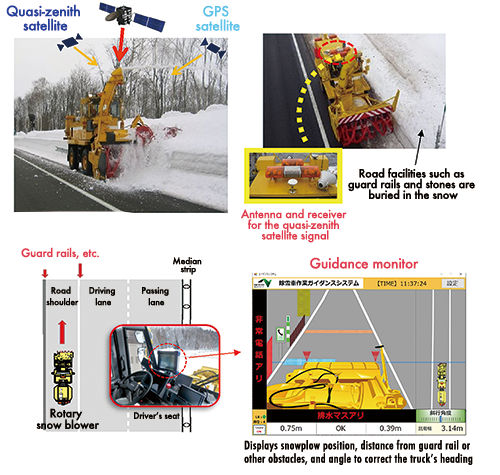February 2020
A Satellite Guide for Snow Blowers

Japan’s highways have introduced snow blowers that safely clear roads using positional information from satellites, accurate nearly down to the centimeter.
Snow removal vehicles in high-snowfall areas of Japan need to work around the clock in winter to keep the roads safe. East Nippon Expressway Company Limited (“NEXCO East”) is a highway operator whose service area includes high-snowfall locations like Hokkaido and the Tohoku region. Of the 3,943 km of roads operated by the company, about 2,500 km—over 60%—runs through Japan’s snow belt, receiving more than a meter of snow cover in winter. The company’s total distance plowed for the 2018 fiscal year came to 460,000 km, equivalent to ten times the earth’s circumference. According to Nakatani Ryo, Senior Snow & Ice Specialist in NEXCO East’s Technology & Environmental Department, snow removal vehicle operators require a sophisticated set of veteran skills.
“When the road surface and shoulders are covered in snow, you can’t use the road lines or shoulder guard rail to guide you. Falling snow obscures your vision as well, so you need to know the road condition well and drive very delicately. And you need to operate the plow at the same time. That’s why it takes such skill and experience.”
However, Nakatani says there are concerns of snow removal labor shortages as the most skilled veterans grow older. This is why NEXCO East began working on the development of an operation support system for snow blowers in 2013. Following verification tests, the system entered practical operation in January 2018.
The operation support system for snow blowers uses precise positional information sent by Michibiki, Japan’s quasi-zenith satellite system. Since Michibiki’s orbit keeps it positioned directly above Japan at all times, it can broadcast radio signal to mountain corridors or other areas which are difficult to reach with GPS signal, enabling consistent, uninterrupted positioning.
There are two main kinds of snow removal vehicles: snow plow trucks, which push road snow off to the shoulders, and rotary snow blowers, which remove snow collected on the road shoulders. The operation support system for snow blowers combines precision positioning data with high-resolution 3D mapping data to display the position of rotary snow blowers currently operating on the highway—accurate nearly down to the centimeter—on a driver’s seat guidance monitor. This allows snow blower drivers to accurately remove snow from the road shoulders, even when snow obscures their view of the white line separating the shoulder from the driving lane.
“The driver’s seat monitor displays driving lane overlap and where to point the truck or how to correct its trajectory in order to avoid contact with the guard rail. This enables even less experienced operators to plow safely and surely,” says Nakatani.
In February 2018, NEXCO East conducted a demonstration of snow removal on straight and curved lines using the rotary snow blower equipped with the driving support system. They confirmed the vehicles were able to remove the snow without straying from the planned course.
One veteran snow blower operator expressed his surprise at the results, saying, “Even if you can’t see the lines in the road at all, you can see the point where the driving lane approaches the curve and determine the right way to turn the wheel. This should be plenty effective, even during a whiteout.”
Nakatani says, “I heard an operator who was interviewed on the day said, ‘This system is equivalent to about ten years’ driving experience.’”
The issue is the implementation cost. The receiver and antenna to pick up the signal from Michibiki are both expensive, since they have only just been developed and the market still has to catch up. There are also heavy costs associated with creating the high-resolution map.
“It’s predicted that more and more car navigation systems will come to use Michibiki in the future. We expect this market expansion will help reduce cost. Although the precision maps are currently provided by a mapping company, we are considering creating our own proprietary mapping technology,” says Nakatani.
Since January 2018, the operation support system for snow blowers has been operating on a trial basis on a 21-km stretch of the Hokkaido Expressway between Iwamizawa and Bibai. Having now reached its third winter, NEXCO East is working to improve the guidance monitor’s position, information display, and screen design based on the opinions of operators actually using it to plow the roads.
“In the future, we plan to expand the area of operation and install the system on faster snow plow trucks capable of clearing driving lanes at 50 kph. After that, we will aim to safely automate the snow removal process, incorporating automated driving technology,” says Nakatani.


